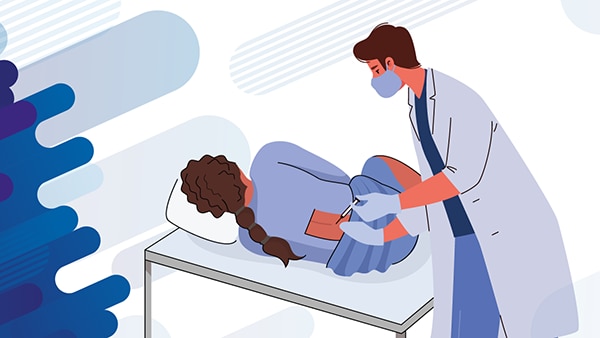Key points
- Fungal meningitis is a rare but life-threatening fungal infection that usually occurs in patients with immunocompromising conditions.
- It's most often acquired by inhaling fungal spores from the environment.
- Healthcare-associated fungal meningitis is very rare. Outbreaks are likely caused by inadequate infection prevention and control practices or contaminated medications.
- Initiate prompt appropriate antifungal therapy to improve patient outcomes.

Overview
Fungal meningitis occurs when a fungal infection causes inflammation of the fluid and membranes surrounding the brain and spinal cord. It is a rare but life-threatening condition that requires treatment with antifungal drugs.
The precise incidence of fungal meningitis is difficult to know because these conditions aren't reportable in most U.S. states. Mortality rates vary depending on the pathogen and patient characteristics, but even with treatment, mortality rates can approach 50%.
Usually, fungal meningitis occurs in patients with weakened immune systems such as people with:
- Cancer
- Stem cell or solid organ transplantation
- Advanced HIV disease
- Immunosuppression from chemotherapy and corticosteroids
Healthcare-associated fungal meningitis is very rare, but outbreaks have occurred in immunocompetent persons. These outbreaks have been associated with inadequate infection prevention and control practices or contaminated medications.
Cause
Fungal meningitis (non-healthcare-associated)
Many fungi that can cause meningitis live in the environment, such as Cryptococcus, Histoplasma, Blastomyces, and Coccidioides. Usually, fungal meningitis develops after a fungal infection spreads from another part of the body. For example, patients may inhale fungal spores that initially cause a lung infection that spreads to the brain or spinal cord.
People at the greatest risk of fungal meningitis include:
- Those with conditions that weaken the immune system
- Very premature infants
- Persons taking immunosuppressive medications (e.g., steroids, post-transplant immunosuppressive drugs).
Although rare, people without immunocompromising conditions can develop fungal meningitis.
Prevention
No specific activities are known to cause fungal meningitis. People with weakened immune systems can reduce their risk by taking these precautions:
- Try to avoid areas with a lot of dust like construction or excavation sites.
- If patients can't avoid these areas, wear an N95 respirator (a type of face mask) while they are there. Click for more information about respirators.
- Stay inside during dust storms and close windows.
- Avoid activities that involve close contact to dirt or dust, including yard work, gardening, and digging.
- Use air filtration measures indoors.
- Clean skin injuries well with soap and water.
- This reduces the chances of developing a skin infection, especially if the wound was exposed to dirt or dust.
- Take preventative antifungal medications if prescribed.
Diagnosis and treatment
Diagnosis and treatment for fungal meningitis depends on patient characteristics and which type of fungal infection is suspected.
Healthcare-associated fungal meningitis
While rare, medical and surgical procedures can lead to fungal meningitis. This occurs if medical devices or medications are contaminated with fungi or if proper infection control practices are not observed.
Healthcare-associated fungal meningitis outbreaks have occurred among patients who received corticosteroid injections or epidural anesthesia. Appropriate manufacturing and infection control procedures can help prevent these healthcare-associated infections.
Regardless of symptom severity, consider testing any patient with signs and symptoms of meningitis who recently had epidural anesthesia or injections. Testing is especially important if medical procedures are linked to products or supplies associated with other fungal meningitis cases. Some patients with fungal meningitis initially have mild or nonspecific symptoms.
Testing for possible healthcare-associated fungal meningitis

Diagnostic testing for fungal meningitis is challenging and susceptible to false-negative results. Fungal culture results are often negative and take up to 2 weeks to turn positive. Additionally, infections may involve multiple fungal pathogens or a combination of bacterial and fungal pathogens. Recommended diagnostic procedures for patients with suspected fungal meningitis include:
- Diagnostic lumbar puncture (LP) unless contraindicated to collect cerebrospinal fluid (CSF)
- Blood collection
Skin infection over the puncture site or a brain mass causing increased intracranial pressure are reasons LP may be contraindicated.
CSF and blood testing can include:
- Fungal and bacterial cultures
- Serum and CSF (1,3)-Beta-D-Glucan testing
- Optional tests include serum Aspergillus galactomannan and CSF fungal polymerase chain reaction test (PCR) or other nucleic acid amplification test (NAAT)
- Next-generation metagenomic sequencing testing
- Antifungal susceptibility testing
Treatment and recovery
Consult with an infectious disease specialist when determining treatment approaches. After obtaining CSF, immediately begin treatment in patients with suspected fungal meningitis. Treatment should not be withheld because of negative fungal culture or (1,3)-Beta-D-Glucan results.
Treatment should involve broad spectrum antifungals that have adequate central nervous system penetration. Dual and triple therapy can be considered and has been used in previous fungal meningitis outbreaks. Antifungal susceptibility testing results may help inform treatment decisions for fungal meningitis cases caused by molds.
Resources
Health Alert Network (HAN) Update: Important Updates on Outbreak of Fungal Meningitis is U.S. Patients Who Underwent Surgical Procedures under Epidural Anesthesia in Matamoros, Mexico
